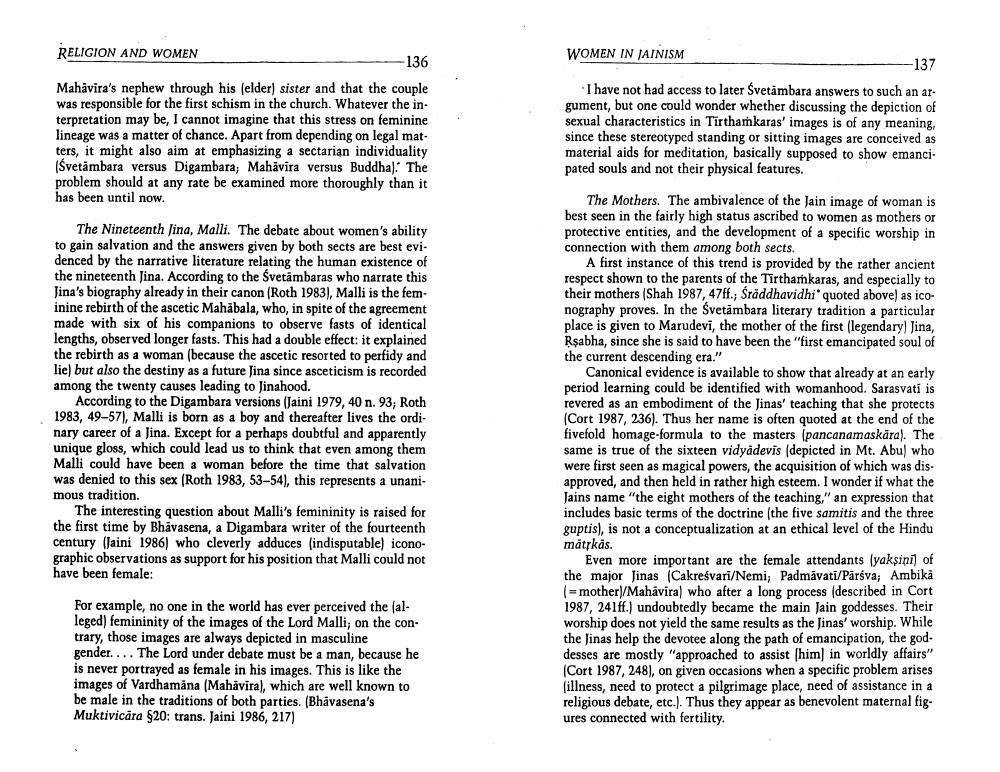________________
RELIGION AND WOMEN
WOMEN IN JAINISM
-136
-
137
Mahavira's nephew through his (elder) sister and that the couple was responsible for the first schism in the church. Whatever the interpretation may be, I cannot imagine that this stress on feminine lineage was a matter of chance. Apart from depending on legal mat ters, it might also aim at emphasizing a sectarian individuality (Svetambara versus Digambara; Mahavira versus Buddha). The problem should at any rate be examined more thoroughly than it has been until now.
I have not had access to later Svetambara answers to such an ar gument, but one could wonder whether discussing the depiction of sexual characteristics in Tirthamkaras' images is of any meaning, since these stereotyped standing or sitting images are conceived as material aids for meditation, basically supposed to show emanci. pated souls and not their physical features.
The Nineteenth Jina, Malli. The debate about women's ability to gain salvation and the answers given by both sects are best evidenced by the narrative literature relating the human existence of the nineteenth Jina. According to the Svetambaras who narrate this Jina's biography already in their canon (Roth 1983), Malli is the feminine rebirth of the ascetic Mahabala, who, in spite of the agreement made with six of his companions to observe fasts of identical lengths, observed longer fasts. This had a double effect: it explained the rebirth as a woman (because the ascetic resorted to perfidy and lie) but also the destiny as a future Jina since asceticism is recorded among the twenty causes leading to Jinahood.
According to the Digambara versions (Jaini 1979, 40 n. 93; Roth 1983, 49-57), Malli is born as a boy and thereafter lives the ordinary career of a Jina. Except for a perhaps doubtful and apparently unique gloss, which could lead us to think that even among them Malli could have been a woman before the time that salvation was denied to this sex (Roth 1983, 53-54), this represents a unanimous tradition.
The interesting question about Malli's femininity is raised for the first time by Bhavasena, a Digambara writer of the fourteenth century (Jaini 1986) who cleverly adduces (indisputable) icono graphic observations as support for his position that Malli could not have been female:
The Mothers. The ambivalence of the Jain image of woman is best seen in the fairly high status ascribed to women as mothers or protective entities, and the development of a specific worship in connection with them among both sects.
A first instance of this trend is provided by the rather ancient respect shown to the parents of the Tirthamkaras, and especially to their mothers (Shah 1987, 47ff., Sräddhavidhi' quoted above) as iconography proves. In the Svetambara literary tradition a particular place is given to Marudevi, the mother of the first (legendaryl Jina, Rsabha, since she is said to have been the "first emancipated soul of the current descending era."
Canonical evidence is available to show that already at an early period learning could be identified with womanhood. Sarasvati is revered as an embodiment of the Jinas' teaching that she protects Cort 1987, 236). Thus her name is often quoted at the end of the fivefold homage-formula to the masters (pancanamaskāra). The same is true of the sixteen vidyadevis (depicted in Mt. Abul who were first seen as magical powers, the acquisition of which was disapproved, and then held in rather high esteem. I wonder if what the Jains name "the eight mothers of the teaching." an expression that includes basic terms of the doctrine (the five samitis and the three guptis), is not a conceptualization at an ethical level of the Hindu matkas.
Even more important are the female attendants (yaksini) of the major Jinas (Cakreśvari/Nemi, Padmavati/Pårsva; Ambika (mother/Mahavira) who after a long process (described in Cort 1987, 241ff.) undoubtedly became the main Jain goddesses. Their worship does not yield the same results as the Jinas' worship. While the Jinas help the devotee along the path of emancipation, the god desses are mostly "approached to assist him in worldly affairs"
Cort 1987, 248), on given occasions when a specific problem arises (illness, need to protect a pilgrimage place, need of assistance in a religious debate, etc.). Thus they appear as benevolent maternal figures connected with fertility.
For example, no one in the world has ever perceived the (alleged) femininity of the images of the Lord Malli; on the con trary, those images are always depicted in masculine gender.... The Lord under debate must be a man, because he is never portrayed as female in his images. This is like the images of Vardhamana (Mahavira), which are well known to be male in the traditions of both parties. (Bhåvasena's Muktivicara $20: trans. Jaini 1986, 217)




